The Archos G9 Tablet Reviews: Fast Enough
by Jason Inofuentes on May 23, 2012 12:45 PM ESTIn the 10 months since we first heard that Archos would be leveraging the 1.5 GHz TI OMAP 4460 in their tablet line, our excitement has waned. We’ve seen tablets sporting Samsung’s Exynos, NVIDIA’s Tegra 3 and even played with some Krait tablets, all of which can seriously outperform TI’s current gen champ. But this performance sure is nice. To review, TI’s OMAP 4460 includes two ARM Cortex-A9 cores, and Imagination Technologies’ PowerVR SGX540 all on a 45 nm process. The lesser kin to our subject is the TI OMAP 4430, though to look at their spec sheets they should only differ in clock speeds, with the 4430 topping out at 1.2 GHz on the CPU and 304 MHz on the GPU and the 4460 topping out at 1.5 GHz and 384 MHz, respectively.
So, if the two OMAP 4 variants ultimately differ by their 25% clock difference, we should see a similar delta in performance. As always, we start with our JavaScript benchmarks to gauge CPU performance. First, SunSpider and its js time trials.
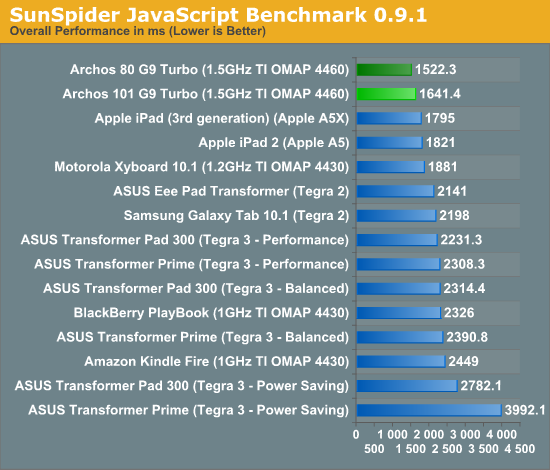
Our hands-on time with the Motorola Xyboard gave us a hint at what to expect. At 1.2 GHz OMAP 4 provides excellent JavaScript performance. At 1.5 GHz, we have a new king of the hill for this particular benchmark. It's hard to say whether there's some optimization trickery at work here, but browsing performance on these tablets was generally excellent.
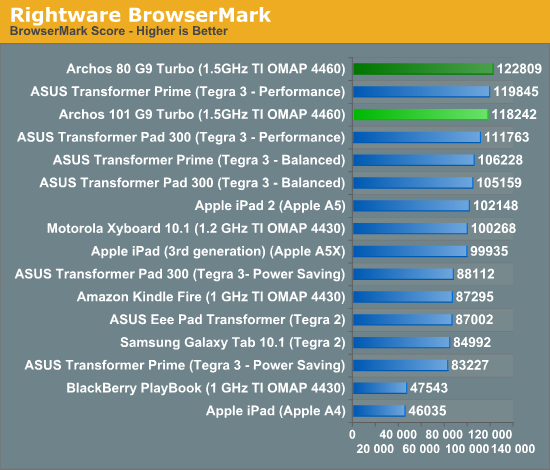
Rightware's Browsermark is another js test that paints the same picture. In both of these tests the delta between the Xyboard and the G9 was about 25% so the leads correlate with the clockspeed advantage. The result is, at least in JavaScript performance, we have the world's fastest tablets.
So how does that old stand-by the SGX 540 fare now that it's been cranked to 384 MHz? We start with GLBenchmark and their off-screen tests, Egypt and Pro. Any test at device resolution would unfairly favor the smaller 80 G9 because of its lower resolution.
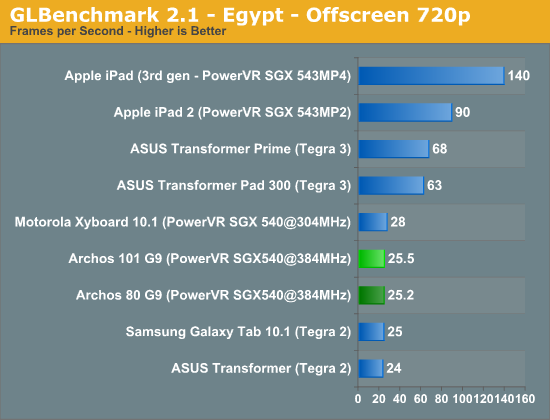
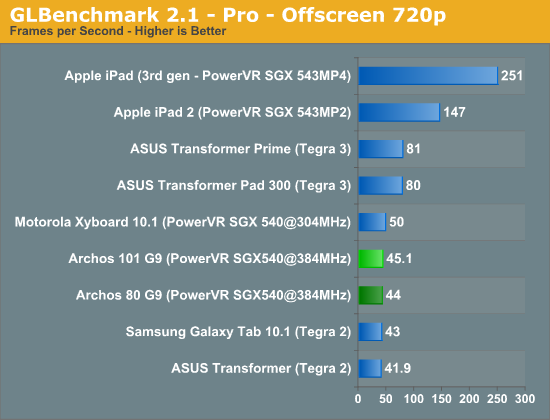
Not quite what we expected. Here the G9's fall behind the lower clocked Xyboard by roughly 10%, and certainly don't demonstrate the performance advantage they showed in the JavaScript tests.
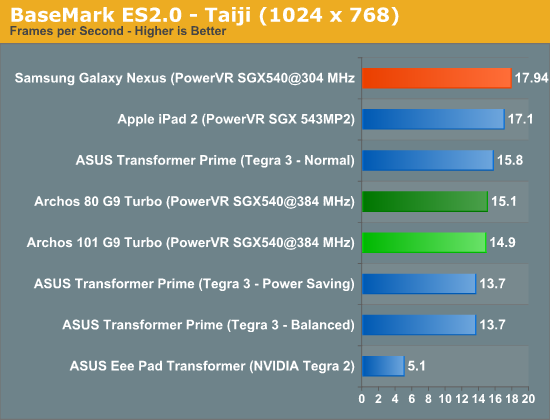
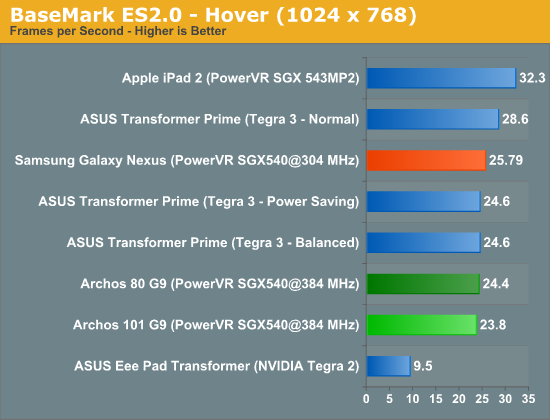
BaseMark's results show much of the same. We didn't record data for the Xyboard, but we did have it for the Galaxy Nexus and its equivalently clocked OMAP 4460. The Nexus bests all but the iPad 2, but the G9's continue to falter by about 10%.
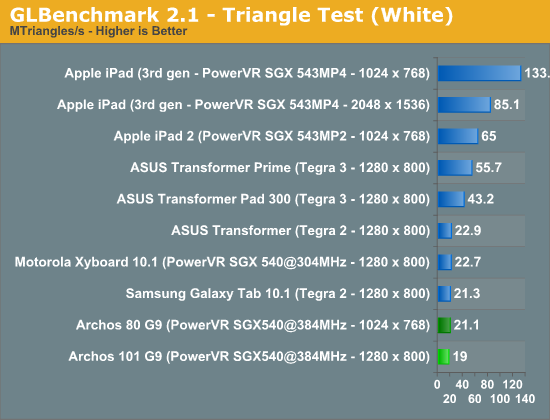
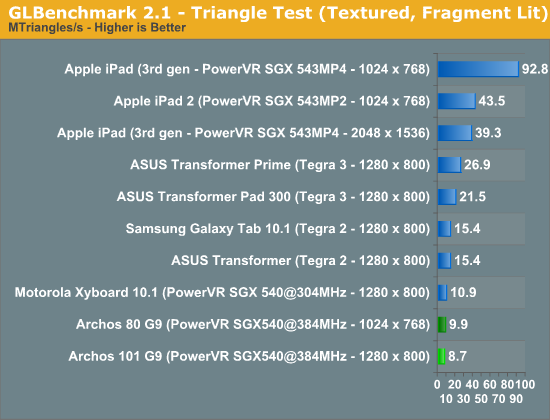
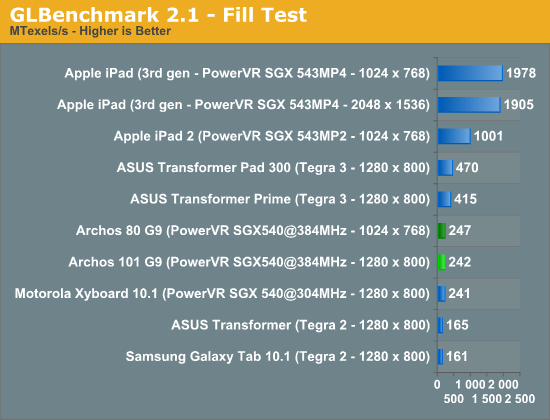










39 Comments
View All Comments
tayb - Thursday, May 24, 2012 - link
Until I saw the picture on page 2. I just assumed they were comparing the iPad 1 with the Archos tablet. This might be the first time I've seen the Tab from the front. Damn. I get that there are only so many ways to make a tablet but wow those look similar.aliasfox - Thursday, May 24, 2012 - link
And you wonder why Apple thought there might be a problem. Unless you're able to compare aspect ratios (hard to do unless they're side by side), a Tab is eerily similar to an iPad from the front.Dex1701 - Thursday, May 24, 2012 - link
Wait, did they mention that they played Shadowrun on this thing? That's not coming out until next year, is it?hans007 - Thursday, May 24, 2012 - link
i have a g9 80 . the 1GB of ram is all the difference for android tablets.my g9 80 is a dual core 1.2 with 512mb ram and 8gb on board.
and i have a galaxy nexus phone. the phone is smoother in a lot of areas because of not having the need to swap memory in and out.
1GB of ram vs 512mb of ram, isnt just twice as much. its really 3 times as much for user apps since the OS already takes 200mb or so + the video memory.
archos should have put 1GB on these from the start, at least they finally are now.
shomizu9 - Thursday, May 24, 2012 - link
lol, I don't know why but the Domino's icon made me chuckle. Pizza-eating nerd! (me too)JasonInofuentes - Thursday, May 24, 2012 - link
I actually hate their pizza. But I love watching their app do its thing. Ashley has your order. Mike is preparing your dough. Tom is applying your toppings. Heart.lymang - Friday, May 25, 2012 - link
" what we’re hear to discuss today" should be "what we're here to discuss today."g00ey - Saturday, May 26, 2012 - link
I could easily fit 128GB of audio content into such a device. Not all audio is mp3 and I prefer the lossless flac format so it's about time that one will be able to keep flacs in the media player. Please remind me that this is 2012 and not 2002!!!A fair quality HiDef movie takes on average 5GB of storage space. I don't consider keeping about 20 such movies in the device excessive. Sure a standard def movie would do well on a small 8" or 10" screen but who is to say that I don't intend to hook it up to a big screen?
Android games are getting bigger and bigger. The popular title Modern Combat 3 requires about 1.5GB of storage space. The performance of the chips have surpassed the XBOX and PS2 and we will see a performance comparable to PS3/XBOX360 within the next few generations if we're not there already with the Tegra3. So at the very least we will see DVD sized games on portable devices quite soon and they are likely to grow beyond 15GB within the next 5 years or so.
So putting it all together, I want to have a good collection of music because I like music. Say I want to travel for a while so a good set of decent movies when I'm bored would be nice. Top that with a bunch of nice games. How much space would I have left for photos and HiDef video clips that I have shot from time to time? And don't say "cloud", that is so over the hill by now and relying on some questionable mobile data connection just doesn't cut it!
TimeHunter - Monday, June 4, 2012 - link
I had the previous version tablet (until a theft), the 7.0 Internet, with the 250GB HDD in it. I used it primarily for travelling and it lasted quite well, even on longer plane flights. It wouldn't make a transoceanic flight without a booster, but it handled all the transcontinental flights just fine for battery life. Archos did pretty well for patching the version of the OS it released on, but there was no apparent interest, and no communication, on getting it past Gingerbread.But, sometimes the latest OS isn't what is needed (gasp!). It actually ran quite well, and was a pleasure in the media department as I could carry my entire large music collection and a good handful of my movie files. The codec support was the best of any device out there, even to date.
The HDD did make for some lag in the OS and app experience, but that was not unexpected, so it was not disappointing. Once they added support for the EXT3 storage format to support files larger than 4GB, it was really quite awesome.